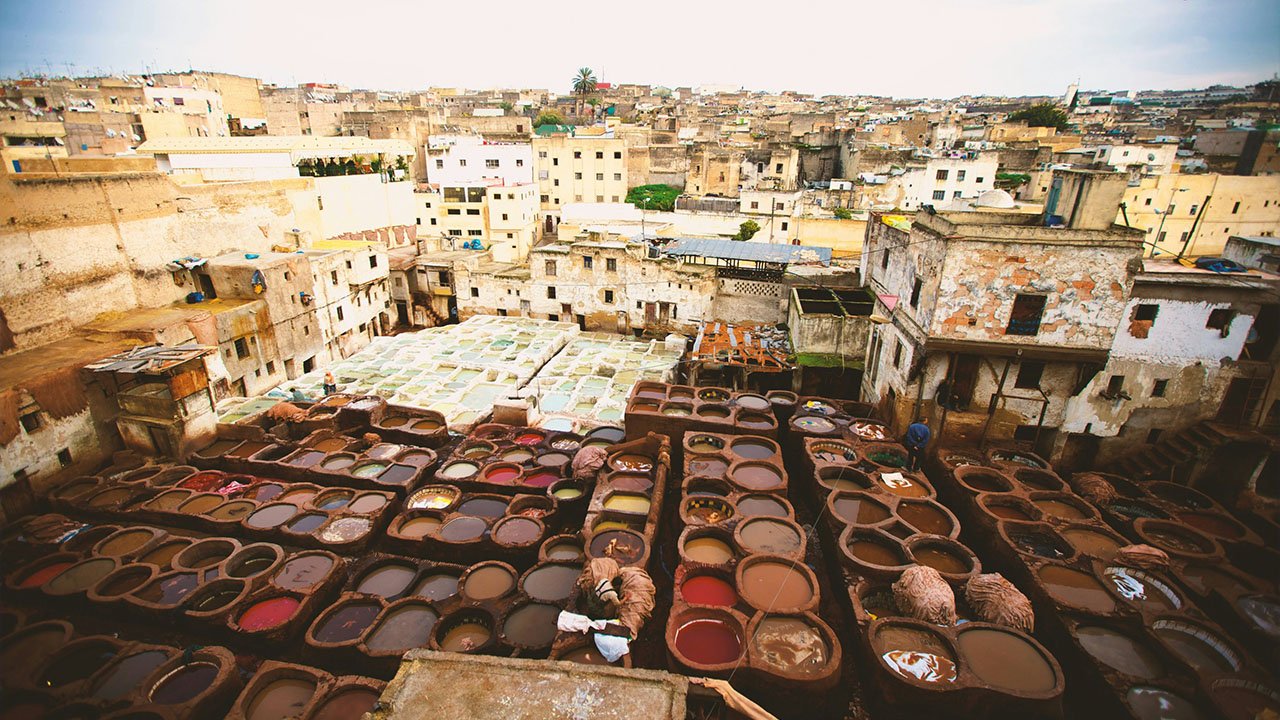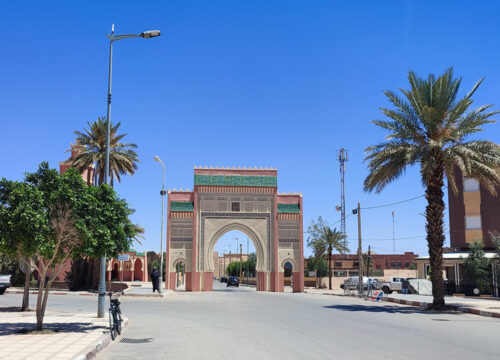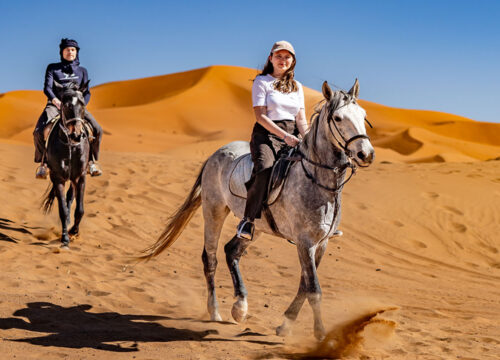Fes, a pivotal city within the realm of ancient Morocco, serves as the central urban area in a region nestled in the heart of Morocco. The Oued Sebou river, traversing the region from east to west in its wider middle course, irrigates a vast plain where a variety of crops such as cereals, vineyards, and olive orchards thrive.
To the north, the environment gradually shifts towards wilder terrain, culminating in the peaks of the Rif mountains, where dense woodlands provide a sanctuary for an abundance of game, making it a hunter’s paradise.
In the southern direction, the terrain gently ascends towards the majestic Atlas mountains. These regions, characterized by their calcareous soil, are adorned with expansive olive groves and are dotted with white-washed villages and prestigious towns, boasting well-preserved Baroque architecture.
This mountainous region hosts a diverse array of wildlife. The province of Fes, steeped in a history that traces back to the Iberians, Romans, and Moors, is a bastion of tradition; it boasts a remarkable architectural legacy and has seen a significant revival in its culinary practices, with a resurgence of traditional regional dishes.

Geographical Position
Situated in the north-central part of the Kingdom of Morocco, the province of Fes is bordered by the provinces of Meknes, Taza, Ifrane, and Moulay Yacoub.
Fes serves as the province’s capital city.
Historical Overview
From the Paleolithic era, the province of Fes has witnessed the influence of humanity. Battles for this territory were fought between the ancient Berber tribes over its valuable resources, including iron, lead, and copper mines.
The Romans, captivated by its enchanting landscapes and fertile valleys, left a lasting impression with numerous architectural marvels. Following the spread of Islam across the Maghreb, Fes emerged as a critical center for the dissemination of cultural and economic innovations during the medieval period.
With the foundation of the Idrisid dynasty by Idris I and the subsequent growth under its leaders, Fes reached the zenith of its historical importance. The wisdom of renowned scholars – such as Ibn Khaldun and Al-Bakri – contributed to the city’s global prestige and influence.
After the Reconquista and various periods of social upheaval, the province embarked on a new historical path. Presently, this advantageous locale in Morocco is a treasure trove of architectural wonders, promising to enchant even the most discerning of travelers.
Landscape
The province’s landscape is a picturesque blend of olive orchards and vineyards, nourished by the tributaries of the Oued Sebou river, which meanders across the region, dividing it into two distinct areas: the mountainous terrain of the Rif and the fertile plains alongside the river. To the south lies another distinctive region, albeit less extensive, yet elevated: the Atlas mountain range.
Unforgettable Activities in Fes
Morocco If you’re mapping out your journey through southern Morocco and seeking the top experiences in Fes, prepare for an extraordinary adventure! The historic city of Fes, with roots stretching back to the Romans, is teeming with a rich tapestry of history at every turn.
Fes, Morocco, has served as a Roman city, an Islamic stronghold, and a jewel in the crown of the Moroccan kingdom. Across Fes and the broader region of northern Morocco, the confluence of these civilizations and religions is evident in the architecture, the art, and the traditional cuisine that is found throughout the area.
What to Discover in Fes?
-
Bou Inania Madrasa
Be Awed by the Bou Inania Madrasa. The Bou Inania Madrasa is one of Fes’s most iconic landmarks. Initially constructed as an Islamic school in the 1350s, this site has witnessed the city’s transformation across various eras, including periods under Islamic influence.
After centuries of Islamic scholarship, the site continued to play a pivotal role in the city’s religious and educational life. Today, the Madrasa stands as a testament to Fes’s rich history, recognized as a UNESCO World Heritage Site. Its stunning Moroccan architecture, with intricate tile work and carved wood, captivates visitors from the moment they step inside.
The mix of architectural styles reflects the cultural fusion characteristic of the region, from the iconic Moroccan arches to the detailed Islamic calligraphy.
Though Fes is home to many historical sites, the Bou Inania Madrasa’s beauty and historical significance make it an absolute must-see. Visitors often opt for guided tours to fully appreciate its history and architectural beauty. Alternatively, securing your entry tickets upon arrival allows for a self-guided exploration.
-
Royal Palace of Fes
Explore the Royal Palace of Fes. Just a short walk from the Bou Inania Madrasa lies the Royal Palace of Fes, a magnificent example of Moroccan architecture built in the 14th century. It served as a royal residence and a symbol of the kingdom’s power. This palace, too, is celebrated as part of Fes’s UNESCO World Heritage. The palace itself is a marvel, with remnants of exquisite 14th-century decor. Visitors can admire the grandeur of its design and the surrounding gardens, which feature a harmonious blend of lush greenery and vibrant flowers, accented by traditional Moroccan water features.
-
Fes el-Bali
Stroll through Fes el-Bali. Fes el-Bali, the ancient heart of Fes, is synonymous with the city’s rich historical tapestry, housing landmarks like the Bou Inania Madrasa and the Royal Palace. Recognized as a UNESCO World Heritage Site, this neighborhood’s narrow, winding streets are lined with whitewashed buildings, vibrant markets, and artisan workshops, offering a glimpse into the city’s past and present. Embark on a self-guided tour or join a guided walk to unearth the history of this ancient city center, a pivotal thing to do in Fes.
-
Bab Bou Jeloud
Enter through the Bab Bou Jeloud. The Bab Bou Jeloud, or the Blue Gate, is Fes’s most iconic entryway, dating back to the early 20th century and providing access to Fes el-Bali. This gate, adorned in blue on the exterior and green on the interior, symbolizes the transition into the historic heart of Fes, and its design reflects the city’s unique architectural heritage.
-
Ruins of Volubilis
Visit the Ruins of Volubilis. Located approximately 33 miles from Fes, Volubilis is the site of ancient Roman ruins and the city’s third UNESCO World Heritage Site. Founded in the 3rd century B.C., it served as a crucial Roman administrative city. The city was abandoned after centuries, rediscovered in modern times, and has undergone partial excavation, revealing its historical significance. Accessible by car, a visit to Volubilis can be planned before or after your exploration of Fes. It’s advisable to purchase entry tickets at the on-site museum and possibly take a shuttle or join a guided tour for a comprehensive understanding of this archaeological marvel.
-
Tanners’ Quarter
Admire the Views from Tanners’ Quarter. No visit to Fes is complete without witnessing the colorful spectacle of the Tanners’ Quarter. This area, known for its traditional leather dyeing pits, offers a unique insight into the ancient practices that have defined Fes’s craft heritage. The vibrant colors and traditional methods used here are a photographer’s dream, capturing the essence of Fes’s artisanal spirit.
-
Nejjarine Museum
Discover the Nejjarine Museum of Wooden Arts & Crafts. Housed in a beautifully restored funduq (a historic inn), the Nejjarine Museum offers a fascinating look into Morocco’s woodcraft traditions, with exhibits ranging from intricately carved doors to musical instruments. It’s an essential stop to appreciate the country’s rich artisanal heritage.
-
Ancient Medina
Cross the Ancient Medina’s Bridges. Fes’s medina is known for its historic bridges, offering picturesque views and a pathway through the city’s vibrant life. These bridges, some dating back to the medieval era, are not only functional but also historical landmarks, connecting different parts of the city and offering unique perspectives on daily life in Fes.
-
Dar Batha Museum
Visit the Dar Batha Museum. Positioned near the Blue Gate, the Dar Batha Museum is set in a former royal palace and showcases Moroccan arts, including pottery, jewelry, and textiles. The museum’s collection offers insight into the region’s cultural and artistic achievements, making it a worthwhile visit for those interested in the depth of Moroccan craftsmanship.
-
Fes’s Patios
Explore Fes’s Patios. Fes is known for its stunning courtyards or patios, designed to offer a cool retreat from the city’s heat. These hidden gems, often part of private residences or public buildings, are adorned with tiles, fountains, and lush plants, reflecting the Moroccan architectural style. Visitors during the Fes Festival of World Sacred Music can enjoy some of these patios, which open to the public for concerts and events, offering a rare glimpse into the city’s architectural beauty.
-
Palais Glaoui
Wander through the Palais Glaoui. The Palais Glaoui, a historic palace, offers a window into the opulent lifestyle of Fes’s former elite. Though less known, its courtyards and reception rooms, decorated with tiles and carved wood, are a testament to the city’s architectural splendor.
-
Fes’s Culinary Delights
Savor Fes’s Culinary Delights. Fes prides itself on its culinary heritage, offering an array of traditional dishes that reflect the city’s rich cultural influences. From the savory pastilla to the sweet mint tea, each dish tells a story of Fes’s historical and cultural fusion.
Q- Is Fes safe to visit?
A- There are generally no specific travel advisories against visiting Fes. It’s a city rich in history and culture, frequented by tourists for its ancient medina, traditional crafts, and food. As with any tourist destination, it’s advised to stay aware of your surroundings and take general safety precautions.
Q- What is the best time to visit Fes?
A- The best times to visit Fes are from March to April and from September to November. These months offer pleasant weather, making it comfortable to explore the city. The shoulder seasons also mean fewer tourists and potentially lower prices for accommodations.
Q- What city are the famous tanneries in?
A- Fes, the city is renowned for its historic tanneries, where the traditional methods of dying leather have been practiced for centuries. The most famous of these is the Chouara Tannery, a must-visit for those interested in understanding the city’s artisanal heritage.
Q- What is there to do in Fes in 2 days?
A- In two days in Fes, visit the historic medina (Fes el Bali), Al Quaraouiyine University (the world’s oldest), the Merenid Tombs, Bab Boujloud (the Blue Gate), the Bou Inania Madrasa, and the Nejjarine Museum of Wooden Arts & Crafts. Exploring the tanneries and sampling local cuisine in the medina are also highly recommended.
Q- How much does a trip to Fes cost?
A- A guided tour of the medina and key historic sites usually costs around $50 to $70 per person. Costs can vary based on the specifics of the tour and included sites. Dining, shopping, and accommodations can vary widely in price depending on personal preferences and budget.
Q- Where is best to stay in Fes to experience the culture?
A- Staying within or near the Fes el Bali (the old medina) is ideal for those looking to immerse themselves in the city’s rich history and culture. Here, you’ll find accommodations ranging from luxurious riads to more budget-friendly guest houses, all offering a taste of traditional Moroccan hospitality.
Q- How should I dress in Fes?
A- While there’s no requirement to cover your head, dressing modestly is recommended out of respect for the local culture. Loose fitting, lightweight clothing is advisable due to the warm climate, especially in the busy medina. Opt for colors that conceal dust and dirt as the narrow streets can be bustling and occasionally dusty.
Q- Is it worth visiting areas outside Fes?
A- Absolutely, regions outside Fes offer a variety of experiences, from the ancient Roman ruins of Volubilis to the scenic Middle Atlas Mountains. Each provides a unique glimpse into the diverse landscapes and histories that comprise Morocco. Day trips or longer excursions can be easily arranged from Fes.







